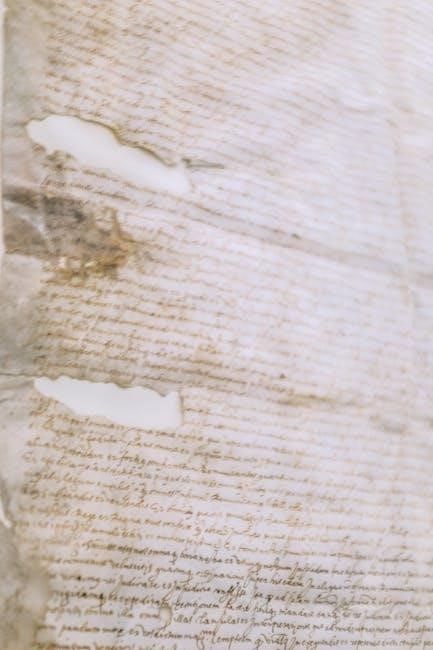Inscription in Dragonflight is a versatile crafting profession that creates glyphs, scrolls, and magical items. It plays a key role in the expansion’s economy and character customization, offering unique benefits for players seeking to enhance their abilities and earn gold. This guide provides a comprehensive approach to mastering Inscription, from leveling to endgame success.

1.1 What is Inscription in Dragonflight?
In Dragonflight, Inscription is a crafting profession that focuses on creating glyphs, scrolls, and other magical items. It allows players to enhance their spells and abilities by crafting glyphs, which can be applied to spells to modify their effects. Inscription also involves creating items like vellum, scrolls, and cards, which are used for various purposes in the game. The profession relies heavily on herbs and other materials, making Herbalism a complementary skill. Inscription is particularly valuable for players who enjoy customizing their characters’ abilities and for those looking to earn gold through crafting and selling glyphs on the auction house.
1.2 Why Level Inscription in Dragonflight?
Leveling Inscription in Dragonflight is highly rewarding for players who enjoy enhancing their characters’ abilities and making gold. Glyphs, crafted through Inscription, allow players to modify spells, providing a competitive edge in both PvE and PvP. The profession also enables the creation of useful items like vellum and scrolls, which are in demand by other players. Additionally, Inscription pairs well with Herbalism, making it a convenient profession for those who enjoy gathering materials. By leveling Inscription, players can craft high-demand items, earn gold through the auction house, and gain a unique advantage in customizing their characters’ abilities. This makes it a valuable skill for both casual and dedicated players.
1.3 Overview of the Dragonflight Expansion
Dragonflight is the ninth expansion for World of Warcraft, introducing the dragonkin-inhabited continent of Kalimdor’s forgotten region, the Dragon Isles. This expansion brings a wealth of new content, including five expansive zones: the Waking Shores, Ohn’ahran Plains, Azure Span, Thaldraszus, and the Forbidden Reach. It also introduces a revamped class tree system, allowing for deeper customization of abilities. Dragonflight emphasizes exploration, crafting, and player progression, with Inscription playing a key role in enhancing glyphs and magical items. The expansion also features a new tier of gear, dungeons, raids, and a fresh leveling experience. These elements create a dynamic environment where crafting professions like Inscription thrive, offering players meaningful ways to contribute to their characters’ power and the in-game economy.

Preparation for Leveling Inscription
Preparing to level Inscription in Dragonflight requires gathering essential resources, planning your specialization, and understanding the crafting mechanics to ensure a smooth progression. A well-organized approach is key.
2.1 Gathering Materials for Inscription
Gathering materials is crucial for leveling Inscription efficiently. Herbs like Frostweed and Tiger Lily are essential for crafting inks and pigments. You’ll also need Light Parchment and Scribe’s Quill for creating glyphs. These items can be purchased from vendors or crafted using other professions like Herbalism or Enchanting. Additionally, stock up on Ink of the Sea and Starlight Ink, which are used frequently in early recipes. Having a steady supply of materials ensures you can craft without interruptions. Consider using the Auction House to supplement your inventory if gathering materials is time-consuming. Proper preparation now will streamline your Inscription leveling process and save valuable time in the long run.
- Gather or purchase herbs like Frostweed and Tiger Lily.
- Acquire Light Parchment and a Scribe’s Quill.
- Stock up on Ink of the Sea and Starlight Ink.
- Use the Auction House to fill material gaps.
2.2 Choosing Your Inscription Specialization
In Dragonflight, Inscription offers three specializations: Glyphs, Scrolls, and Tarot Cards. Each path caters to different playstyles and goals. Glyphs are ideal for players who want to enhance their spells and abilities, making them a popular choice for crafters. Scrolls focus on creating consumable items like Scroll of Stealth and Scroll of Spirit, which are in demand for dungeons and raids. Tarot Cards are used to craft powerful trinkets, appealing to endgame-focused players. Choose a specialization that aligns with your goals, whether it’s crafting for profit, supporting your guild, or preparing for high-level content.
- Glyphs: Enhance spells and abilities for personal use or sale.
- Scrolls: Create consumables for dungeons, raids, and PvP.
- Tarot Cards: Craft trinkets for endgame performance.
Selecting the right specialization ensures you maximize your Inscription potential and enjoy the gameplay benefits that suit your preferences.
2.3 Setting Up Your Profession
To begin with Inscription, you’ll need to learn the profession from an Inscription trainer, typically found in major cities like Stormwind or Orgrimmar. Equip the Inscription Tool, a required item for crafting. Next, set up a dedicated bank alt to store materials and crafted items, ensuring easy access. Familiarize yourself with the Auction House to sell your goods and monitor demand. Organize your materials using bank tabs or addons like BankItems for efficiency. Finally, craft a few basic items to start leveling and unlock new recipes. Proper setup ensures a smooth progression and maximizes your Inscription potential.
- Learn Inscription from a trainer.
- Equip the Inscription Tool.
- Organize materials and crafted items.
- Monitor the Auction House for demand.
Leveling Inscription: 1-25
Begin by crafting basic glyphs and scrolls to quickly gain skill points. Focus on common recipes to build a foundation for higher-level crafting. Optimize material usage to minimize waste and accelerate progress. This phase establishes the groundwork for more complex recipes as you advance. Keep materials organized and craft consistently to reach level 25 efficiently.
3.1 Starting with Basic Recipes

Starting with basic recipes is essential for new inscribers. These recipes allow you to craft common glyphs and scrolls, which are fundamental for skill progression. Begin with recipes like Minor Healing Glyph or Minor Mana Potion, which require minimal materials. These early crafts not only provide skill points but also introduce you to the basics of Inscription. Focus on using common herbs like Peacebloom or Silverleaf to keep material costs low. Crafting these items will help you understand the mechanics of the profession and prepare you for more complex recipes. Keep experimenting with different combinations to gain confidence and proficiency in your crafting skills.
3.2 Crafting Common Glyphs
Crafting common glyphs is a cornerstone of early Inscription progression. These glyphs provide basic enhancements to spells and abilities, making them highly sought after by low-level players. Start with simple recipes like Glyph of the Minor Healing or Glyph of the Minor Mana Potion, which require minimal materials. Use herbs like Peacebloom and Silverleaf to keep costs low. As you craft, pay attention to the skill gains, as these glyphs are efficient for leveling. While they may not be the most profitable items, they are essential for building your skill and understanding the fundamentals of glyph crafting. Experiment with different combinations to refine your technique and prepare for more complex recipes.
3.4 Optimizing Material Usage
Optimizing material usage is crucial for efficient Inscription leveling. Focus on using the cheapest and most accessible herbs for your current recipes. Prioritize crafting glyphs that use fewer materials to minimize waste. For example, Glyph of the Minor Healing requires only basic herbs like Peacebloom and Silverleaf. Avoid crafting unnecessary items unless they offer significant skill gains. Use the auction house to buy materials in bulk at lower prices. Additionally, consider crafting in batches to reduce material loss from failed crafts. By managing your resources wisely, you can save gold and accelerate your progression through the early levels of Inscription.

Leveling Inscription: 25-50

At this stage, you’ll unlock intermediate recipes, focusing on uncommon glyphs. Prioritize skill progression and manage materials efficiently to avoid waste. Use the auction house to restock herbs and inks, ensuring a steady supply for crafting. This phase is crucial for building a strong foundation before advancing to higher levels.
4.1 Unlocking Intermediate Recipes
At level 25, Inscription unlocks intermediate recipes, introducing uncommon glyphs and scrolls. These recipes are essential for progressing your skill and meeting demand from level 30-. Focus on crafting glyphs like Glyph of the Savior and Glyph of the Purifier, which are in high demand. To unlock these recipes, visit your Inscription trainer and learn the new techniques. Prioritize glyphs that use readily available materials to minimize costs. Experiment with different combinations to optimize material usage. This phase is critical for building a solid foundation before advancing to rare glyphs. Keep an eye on your material stock and use the auction house to restock herbs and inks as needed.
4.2 Crafting Uncommon Glyphs
Crafting uncommon glyphs becomes a focus at level 25, offering improved effects for players. Glyphs like Glyph of the Stag and Glyph of the Hawk are highly sought after for their utility. Use Warlock’s Ink and herbs like Tiger Lily or Stormvine to craft these glyphs. Focus on creating glyphs that align with popular class specs to maximize demand. Experiment with different herb combinations to minimize material waste. Keep an eye on the auction house to identify gaps in supply and capitalize on them. Crafting uncommon glyphs not only advances your skill but also provides a steady income stream. Balance quality and quantity to ensure profitability while progressing through the levels.
4.3 Understanding Skill Ups at Higher Levels
As you progress beyond level 25, skill-ups become less frequent but more impactful. Focus on crafting high-demand uncommon glyphs to ensure steady skill progression. Experiment with recipes that use readily available materials like Warlock’s Ink and Stormvine. Prioritize glyphs with consistent demand, such as those for healers or tanks. Keep track of your material costs to avoid waste. At this stage, skill-ups may require crafting multiple items, so plan your material usage carefully. Use the auction house to identify profitable glyphs and adjust your crafting list accordingly. Balancing quality and quantity ensures efficient skill progression while maintaining profitability. Stay adaptable to market demands and refine your strategy as you approach higher levels.
Leveling Inscription: 50-75
Reaching levels 50-75 in Inscription introduces rare glyphs, enhancing your crafting versatility. Focus on efficiency and material management to maintain progress. This phase balances profitability and preparation for endgame demands, ensuring a smooth transition to advanced crafting.
Rare glyphs in Dragonflight Inscription offer enhanced effects compared to common glyphs, making them highly sought after by players. These glyphs require rare materials and specific recipes, often unlocked through higher-level crafting or vendor purchases. Crafting rare glyphs not only boosts your skill level but also increases your reputation as a skilled inscriber. They are particularly valuable for players optimizing their characters for raids, PvP, or Mythic+ content. Focus on mastering recipes for popular rare glyphs to meet demand and maximize profitability. Managing material costs is crucial, as crafting these glyphs can be resource-intensive. Prioritize glyphs with consistent demand to ensure efficient progression and gold-making opportunities.
5.2 Crafting Glyphs for Popular Specs
Crafting glyphs for popular specializations is a key part of maximizing demand and profitability in Dragonflight Inscription. Identify which classes and specs are currently popular, such as healers or DPS, and focus on glyphs that enhance their core abilities. For example, glyphs that improve healing output or increase damage dealt are often in high demand. Use rare materials to craft these glyphs, ensuring they are of high quality. Research the most sought-after glyphs on your server and prioritize crafting those to meet player needs. This strategy not only helps you level faster but also positions you as a reliable source for endgame players, boosting your reputation and gold income.
5.3 Managing Material Costs
Managing material costs is crucial for maintaining profitability while leveling Inscription. Focus on using lower-cost materials for crafting glyphs and save rare resources for high-demand items. Regularly check vendor recipes to ensure you’re not overspending on unnecessary supplies. Milling extra herbs can provide a steady supply of pigments, reducing reliance on the auction house. Additionally, consider crafting glyphs in bulk to minimize material waste. Keep track of your expenses and adjust your crafting priorities based on material availability. By optimizing your material usage, you can maintain a steady profit margin while progressing through the higher levels of Inscription.

Leveling Inscription: 75-100
Reaching the final stretch of Inscription leveling, focus on mastering high-level recipes and crafting epic glyphs. This phase requires careful material management and attention to detail to ensure optimal progress and prepare for endgame content.
6.1 Mastering High-Level Recipes
Mastering high-level recipes in Inscription is crucial for reaching skill level 100. These recipes require rare materials like Dragon Isles Ink and Rare Herbs, ensuring complexity and power. Focus on crafting glyphs that offer significant stat boosts, as these are in high demand. Experiment with combinations to optimize material usage and minimize waste. High-level recipes often have higher success rates for skilled crafters, making them more efficient. Prioritize recipes that align with your specialization to maximize gains. This phase is about refining your technique and preparing for the final push to 100, where mastery of these recipes will be essential for both profitability and endgame success.
6.2 Crafting Epic Glyphs
Crafting epic glyphs is a pinnacle of Inscription in Dragonflight, offering powerful enhancements for endgame content. These glyphs require rare materials like Dragon Isles Ink and Exquisite Herbs, ensuring their potency. Epic glyphs provide significant stat boosts, making them highly sought after by raiders and Mythic+ players. Crafting them involves multiple steps and higher skill requirements, but the rewards are substantial. Focus on glyphs that complement popular class specializations to maximize demand. Epic glyphs are not only profitable but also essential for optimizing your own character’s performance in high-level content. This phase is about creating items that truly stand out in the game, making your Inscription skills indispensable.
6.3 Final Push to 100
The final push to reach Inscription level 100 in Dragonflight requires focus and efficient use of resources. By this stage, you’ll be crafting high-level glyphs and gear, ensuring your character is optimized for endgame content. Utilize rare materials like Dragon Isles Ink and Exquisite Herbs to craft epic glyphs and other high-demand items. Prioritize recipes that offer the highest skill gains per craft to minimize wasted materials. Additionally, consider crafting items for the auction house to supplement your gold income. This phase is about refining your craft, ensuring you’re prepared for the challenges of endgame content and maintaining a competitive edge in the market.

Making Gold with Inscription
Inscription offers lucrative opportunities to earn gold by crafting high-demand glyphs, scrolls, and items. Focus on popular glyphs, utilize vendor recipes, and sell crafted goods on the auction house efficiently to maximize profits and sustain your gold income throughout the game.
7.1 Crafting for Profit
Crafting for profit in Dragonflight Inscription involves identifying high-demand items and optimizing production. Focus on glyphs, scrolls, and rare materials to maximize income. Research the auction house to find popular glyphs and undercut competitors. Prioritize crafting high-demand glyphs for competitive specs, as they sell quickly. Consider material costs and profit margins to ensure profitability. Use addons like TSM or Auctionator to streamline sales. Crafting in bulk during off-peak hours can yield better prices. Explore niche markets, such as crafting items for less competitive specs or seasonal demands. Stay updated on market trends to adapt your crafting strategy and maintain consistent gold income.
7.2 Selling Glyphs on the Auction House
Selling glyphs on the auction house requires strategic planning to maximize profits. Start by understanding demand for specific glyphs, focusing on popular specs and classes. Post glyphs during peak hours when players are most active. Use addons like TSM or Auctionator to analyze prices and set competitive bids. Avoid undercutting wars by slightly overpricing your glyphs. Post in bulk to reduce listing fees and maintain visibility. Regularly refresh listings to keep them prominent. Consider offering discounts for bulk purchases to attract buyers. Monitor sales trends and adjust your inventory accordingly. Keep a balanced stock of common and rare glyphs to cater to different buyer needs. Consistency and patience are key to long-term success in the glyph market.
7.3 Vendor Recipes for Extra Gold
Vendor recipes in Dragonflight Inscription offer a reliable way to earn extra gold. These recipes, purchased from vendors using materials like herbs and parchment, allow you to craft items with consistent demand. While they may not yield the highest profits, they provide a steady income stream. Focus on crafting items like Glyphs of Stamina or Agility, which are always in demand. Use addons like TSM to track market trends and price your items competitively. Regularly restock and relist to maintain visibility. Vendor recipes are a low-risk, high-reward method to supplement your gold income, especially during slower market periods. Consistency is key to maximizing profits from these recipes.
Advanced Inscription Techniques
Mastering advanced techniques like optimizing crafting paths, using addons for efficiency, and crafting for high-end content can significantly enhance your Inscription progress and profitability in Dragonflight.
8.1 Optimizing Your Leveling Path
Optimizing your leveling path in Dragonflight Inscription involves strategically selecting recipes that provide the best skill gains while minimizing material waste. Focus on crafting recipes that are in high demand, such as glyphs for popular specs, to ensure a steady profit. Prioritize recipes with high material efficiency to conserve resources. Additionally, consider crafting items that can be sold on the auction house to fund your leveling journey. By planning your crafting sequence and adapting to market trends, you can streamline your progression and reduce downtime. Regularly review your crafting plan to ensure it aligns with your goals and resource availability.

8.2 Using Addons for Efficiency
Addons can significantly enhance your Inscription leveling experience by streamlining crafting and material management. TradeSkillMaster (TSM) is a powerful tool for optimizing recipe crafting and managing your inventory. It helps you track material costs, identify profitable recipes, and automate crafting processes. Another useful addon is Can I Mog It, which assists in identifying items that can be used for transmog, helping you declutter your inventory. Additionally, addons like Auctionator simplify selling items on the auction house, allowing you to quickly list glyphs and other crafted goods. By leveraging these addons, you can reduce downtime, maximize efficiency, and focus on leveling your Inscription skill more effectively.
8.3 Crafting for Raid and Mythic+
Crafting for raid and Mythic+ content is a lucrative aspect of Inscription, as players seek powerful glyphs and scrolls to enhance their performance. Glyphs like Glyph of the Stars and Glyph of the Tides are highly sought after for their ability-enhancing properties. Additionally, crafting scrolls such as Scroll of Holy Nova or Scroll of Light’s Wrath can provide raid teams with critical utility. To maximize efficiency, focus on crafting items that align with current raid and Mythic+ meta demands. Use your knowledge of class mechanics to anticipate which glyphs and scrolls will be most valuable. This not only supports your own progression but also creates opportunities to sell these items to other players, boosting your gold income.
Endgame Content and Inscription
Inscription shines in endgame content by crafting high-level glyphs, scrolls, and items that enhance gear and provide critical utility for raids and Mythic+ dungeons, making it indispensable for progression.
9.1 Crafting Gear for Endgame
Crafting gear for endgame content is a cornerstone of Inscription in Dragonflight. At max level, players can create powerful epic-quality items such as bracers, belts, and unique gear that provides substantial stat boosts. These items are highly sought after by raiders and Mythic+ runners, as they offer increased Intellect, Stamina, or other critical stats. Crafting endgame gear requires rare materials like Dragon Isles herbs and high-end inks, which can be challenging to acquire in large quantities. Mastering these recipes not only enhances your character’s performance but also positions you as a valuable asset to your guild and the broader player base, making Inscription a highly rewarding profession for endgame content.
9.2 Preparing for Raids
Preparing for raids in Dragonflight requires inscribers to craft essential items that enhance team performance. Glyphs, particularly those that boost Intellect, Stamina, or spell power, are in high demand. Players should stockpile rare materials like Awakened herbs and High-Level inks to craft these critical items. Additionally, creating scrolls such as Scroll of Intellect or Scroll of Stamina can provide temporary buffs, giving raid teams a competitive edge. Coordinating with your raid group to identify their needs ensures you craft the most valuable items. This preparation not only supports your team but also solidifies your role as a key contributor to your guild’s success in challenging content.
9.3 Reputation and Inscription
Reputation plays a significant role in Dragonflight Inscription, as building relationships with key factions unlocks exclusive recipes and materials. Factions like the Valdrakken Accord and Iskaara Tuskarr offer unique inscriptions and glyphs that enhance raid and Mythic+ performance. Earning reputation through quests and activities grants access to rare inks and herbs, which are essential for crafting high-end items. Additionally, certain reputation tiers unlock vendor recipes for powerful glyphs, making them highly sought after by players. By prioritizing reputation farming, inscribers can gain a competitive edge in both crafting and the in-game economy, ensuring they remain indispensable to their guilds and raid teams.

Conclusion and Final Tips
Mastering Dragonflight Inscription requires patience, strategic planning, and a focus on efficiency. By following this guide, you’ll unlock the full potential of glyphs and magical items, enhancing your gameplay and earning consistent gold. Stay updated with market trends, experiment with recipes, and adapt to changes in the meta. With dedication, you’ll become a skilled inscriber, ready to tackle endgame content and dominate the auction house. Happy crafting!
10.1 Summary of Key Points
Dragonflight Inscription offers a rewarding journey from level 1 to 100, focusing on crafting glyphs, scrolls, and magical items. By strategically choosing specializations, managing materials, and optimizing recipes, players can efficiently progress. The profession shines in creating high-demand glyphs for various classes and specs, making it a lucrative gold-making opportunity. Staying updated with market trends and adapting to player needs is crucial for success. Experimenting with rare and epic recipes at higher levels unlocks advanced crafting potential. Consistent practice, smart material usage, and a focus on endgame preparation will ensure mastery of Inscription in Dragonflight.
10.2 Additional Tips for Success
To excel in Dragonflight Inscription, stay adaptable and experiment with different glyph combinations to meet evolving player demands. Regularly check the auction house to identify profitable trends and adjust your crafting focus accordingly. Utilize addons like TSM or Auctionator to streamline sales and material management. Don’t overlook vendor recipes, as they can provide unexpected gold-making opportunities. Engage with your server’s community to collaborate on crafting needs and share resources. Lastly, keep an eye on patch notes, as balance changes can impact glyph popularity. By combining skill, strategy, and adaptability, you’ll maximize your success in Inscription and dominate the market.
